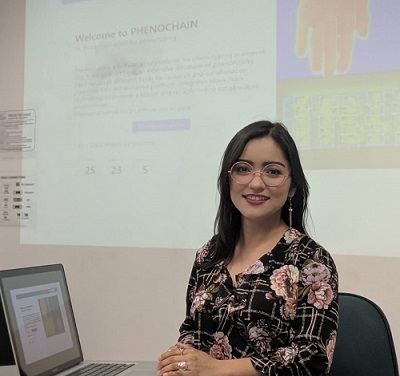
Research Profile: Mayra Samaniego
Plant Phenochain (P2C) - a collaborative platform for plant phenotyping, using blockchain.
Mayra Samaniego, PhD Student in Computer Science (Project 3.1, Project 3.4)
P2IRC Research: Big data analysis and system collaboration
Mayra Samaniego is a University of Saskatchewan (USask) PhD Student in the Department of Computer Science. She speaks to us about her choice of USask for her studies, and her interesting research on blockchain.
Why did you come to Saskatoon to study?
I came to Saskatoon from Ecuador in 2014 to do a Masters program in computer science. I had heard good things about USask and about Saskatoon. I like the size of the city – it is peaceful and quiet and I think it is perfect for concentrating on my studies without distractions. I was excited to receive a Dean’s scholarship for my Ph.D. program; my supervisor was very supportive in helping me achieve that.
Can you provide a brief summary of your research?
Project 3.4 of the P2IRC program is focused on system collaboration. To enable collaboration tools, we have to think about how we will share the data.
There has been a lot of interest in developing hardware technology to collect plant phenotyping data in a non-intrusive manner (sensors, cameras, drones, robots, etc.). Also, there is interest in developing software to process all the data collected. However, there is another area that demands attention. It is how we share the phenotyping data that has been collected and produced from experiments. Thus, we can get the most benefit from it to support global food security – this is called data access control management.
My research in 2016-2017 started with the study of blockchain. Blockchain can be understood as a distributed database that can record data about anything. Data is stored in blocks, and these blocks are connected through a hash value. Once blocks are recorded, they cannot be altered or erased. It has high reliability and security. The following publication provides more information on this.
I also began studying the integration of blockchain and distributed databases to store plant phenotyping data. Following this research, we completed a paper about the “Cassandra” database for plant phenotyping (this paper is being published). Afterwards, I began to study the use of blockchain to build a collaborative platform for plant phenotyping to share and use data ethically and in a secure manner. This research represents the
first blockchain-based system for phenotyping in the University of Saskatchewan and Canada. It clearly shows that blockchain can dramatically change the way we share data.
Why is this research important?
The plant phenotyping data collected and generated at P2IRC has a significant impact on global food security and human life. In P2IRC, we are working with researchers from different USask departments (soil science, plant science, computer science) and institutions (the Global Institute for Food Security, Agriculture and Agri-Food Canada, etc.).
Researchers require a secure and efficient software solution to share data to enable research collaboration. There is an emerging demand to know who is using the data and how. We are creating a collaborative environment that offers researchers the security they desire to share their data. Rather than relying on a traditional centralized administration authority that grants and revokes access to data, we have made the researchers become the administrators of their data. Researchers have the immediate benefit to track the information about who is using their data. Also, they have the responsibility to grant or revoke access to the data they upload and produce. This research is all about protecting Intellectual Property.
What are the next steps in your research?
I am working with my supervisor, Dr. Ralph Deters, as well as with research associate in P2IRC, Cristian Espana. We are extending this research to build a collaborative platform for plant phenotyping
using blockchain.
We have developed a web system (https://p2c.usask.ca), which will be launched after our paper is presented. This system allows researchers from anywhere to upload plant images and use the system tools for segmentation, annotations and classification of data. This system also enables a new way researchers can grant permissions to use their data through blockchain. It is more secure, and will provide researchers the ability to know who, what, where, when and why their data is being used. Students can also access the site to learn and perform experiments, as well as to collaborate with others working in the same field.
How did you become interested in your research?
I studied blockchain in my master’s program, and I am studying blockchain in my Ph.D. program as well. I want to show that blockchain can be applied to different fields, not only cryptocurrencies. In P2IRC, we are using blockchain to manage access to plant phenotyping data to provide a secure and reliable collaborative environment.
How have you grown or developed as a professional result of your research?
The support and resources from the university and my supervisor have allowed me to enhance my researching skills and build my scientific reputation. I have also obtained the opportunity to show my oratory and public speaking background when travelling to international conferences.
What is one of the most interesting findings that you’ve had to date?
What is surprising to me is that while there is an emerging demand for a more efficient process to share data, users may not want the responsibility of managing the access themselves - having tools like the one we are researching forces us all to change our online culture and to behave ethically on the internet.
What do you like to do when you aren’t working on research?
I love dancing, poetry and oratory. I also volunteer with Canada Learning Code.
Research Gate - https://www.researchgate.net/profile/Mayra_Samaniego
Google Scholar - https://scholar.google.ca/citations?user=XTUynsAAAAAJ&hl=en&authuser=1
Personal Website - https://www.mayrasamaniego.com

